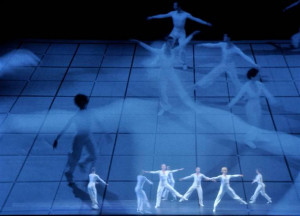
If you're hoping to read a perfectly objective piece of journalism concerning the currently running Lucinda Childs, performance, Dance, then you ought to look elsewhere. If you want to hear all the reasons why I love this performance, then read on. First of all, the album released by CBS as Philip Glass, "Dance Nos 1 and 3" (1980) is one of my favorite records of all time. In fact, I purchased the 12" from KBOO at the late Richard Francis book and record sale. Second, I thought that I may never have the chance to see Lucinda Childs' work, inspired by that wonderful recording. Furthermore, I believed the 2nd movement not on the album would never fall on to my ears.
Whitebird came along and answered my hopes, by bringing Lucinda Childs' Dance Company to the Newmark Theater for a performance of her work Dance (1979), with a recorded score by Glass. The dance was so perfectly tied to the geometry of the music, so flowing, airy as if they were the very spirit of dance, like the music of Glass: precisely defined movements for the individual dancers, organized in to sections, very mathematical. Though Dance is characterized by perfect movement and symmetry, it has this joyful and bouncy feeling about it as the dancers spin, leap, and stretch across the stage in timed measures, gracefully connected to the score provided by Glass.
Dancers perform all in white with bunched up hair, behind the thinnest screen I have ever seen. Projections from the original 1979 piece cover this vail intermittently. Each section is synchronized with the film, which is synchronized to the music almost as well as the live dancers, who are so connected to the rhythm of the music, it's like following the mechanics of a fine watch. The film is set in a large studio with a grid floor. As the image is cast on to live performers, grid and all, perspectives become almost overstimulating. One can not see all live performances, perceive this projected grid in relationship to it, and follow as many as four simultaneous perspectives of the same dance while comprehending polyrhythms and harmony underneath it all. But never does it feel in any way overbearing. The music and dance is so lovely that the time slips away before you could even gauge just how repetitive, yet marginally distinct all the movements were from one another, and how they evolved until the final step.
There is still one more showing of this performance at the Newmark Theater, 7:30pm, Sat Oct. 9th. Free Symposium at Lincoln Hall in PSU at 11am that morning.
Visit whitebird.org for more information.
Click here for a video excerpt.


